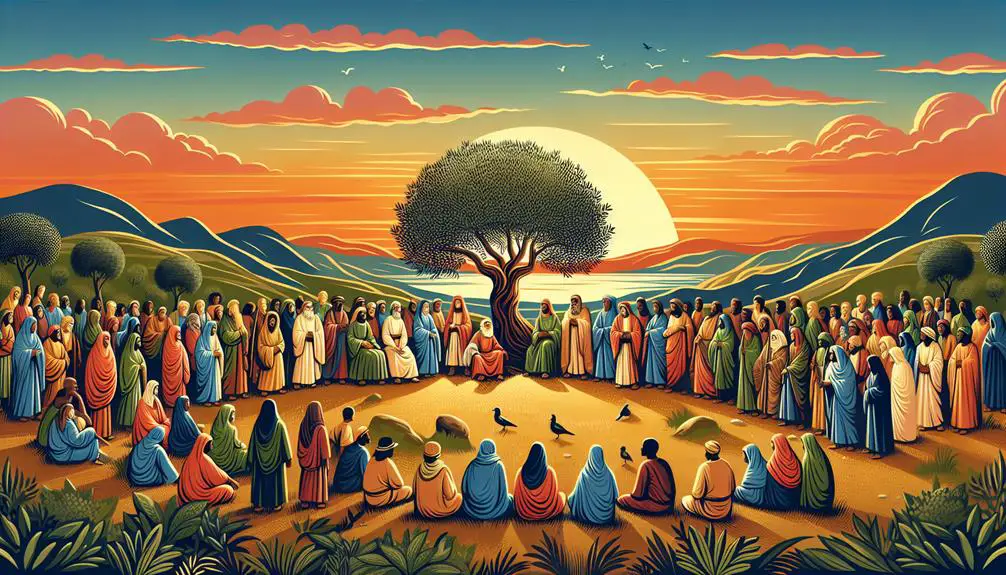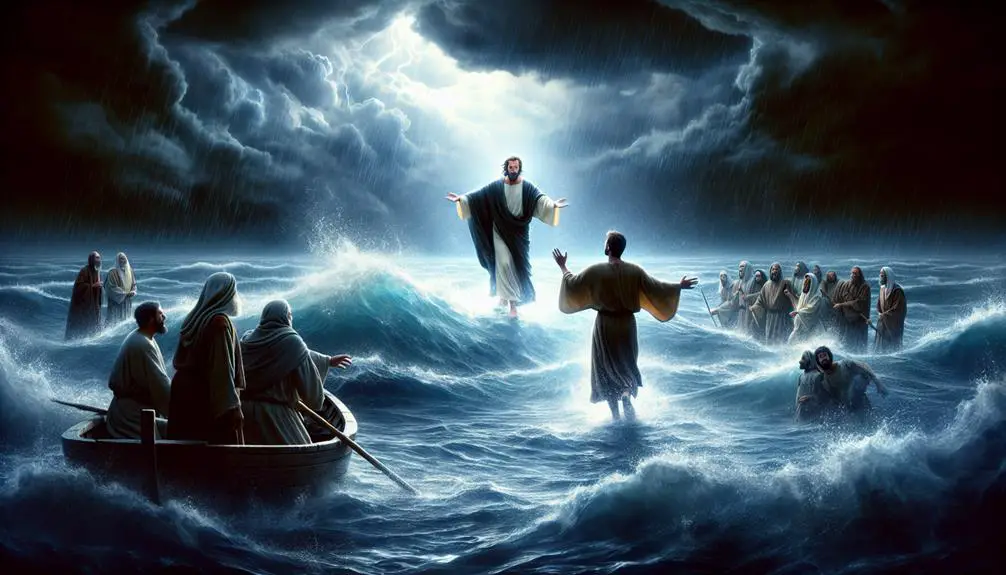Gain insight into the contrasting lives of Simon Peter and Simon the Zealot, two pivotal figures in Christianity with compelling, untold stories.

2 Simons in the Bible
Let's consider Simon Peter, a fisherman whose life took a dramatic turn the moment he chose to follow Jesus. His journey from casting nets to becoming a foundational pillar of Christianity is a tale of faith, failure, and redemption.
On the other hand, we have Simon the Zealot, a figure shrouded in mystery, yet undeniably significant in the early Christian movement. As you ponder the paths of these two distinct individuals named Simon, you're likely to uncover intriguing contrasts and parallels that shed light on their contributions to a faith that has shaped the world.
What might their stories reveal about the diverse nature of leadership and faith?
Key Takeaways
- Simon Peter and Simon the Zealot were two distinct figures with unique paths in early Christianity.
- Simon Peter's journey from fisherman to apostolic leader showcases the transformative power of faith and leadership.
- Simon the Zealot's background highlights the intersection of political and religious fervor in the fight for Israel's liberation.
- Both Simons significantly influenced Christian teachings, symbolizing diverse aspects like faith, zeal, leadership, and passion.
Simon Peter: The Fisherman

Among the most pivotal figures in the New Testament, Simon Peter, initially a humble fisherman, emerged as a cornerstone of early Christian leadership. You'll find his occupation not just a mere detail, but a significant element that shaped his character and his approach to spreading the teachings of Jesus. As a fisherman, Peter possessed qualities such as patience, perseverance, and a deep understanding of the natural world, which he later applied to his spiritual journey and leadership within the early church.
Now, it's crucial to address a common point of confusion that arises when discussing figures of this era – the Zealot confusion. While Simon Peter was a fisherman by trade, another disciple, Simon the Zealot, shared his first name but followed a very different path before joining Jesus' followers. This distinction is important because it highlights the diverse backgrounds of those who were called to be disciples. Peter's background as a fisherman set him apart and equipped him with unique skills and perspectives.
Understanding Peter's occupation provides insight into his leadership style and how he related to the common people, making his teachings accessible and relatable. It's this blend of humility and authority, derived from his life before his calling, that helped establish the early Christian church's foundations. As you delve deeper into the lives of the disciples, remember that their pre-discipleship professions, especially Peter's, played a significant role in shaping their contributions to Christianity.
The Call of Simon Peter

Having explored Simon Peter's background and profession, it's crucial to examine the transformative moment when he was called to follow Jesus, marking a pivotal turn in his journey and the broader narrative of early Christianity. This call didn't just signify a change in vocation for Simon Peter; it was a foundational moment that underscored his future role in the unfolding Christian story.
You'll find the accounts of this call in the Gospels, where Jesus approaches Simon Peter and his companions as they toil unsuccessfully in their fishing endeavors. In a display of divine insight and power, Jesus instructs them to cast their nets once more, resulting in an overwhelming catch. This boat incident isn't merely about the miracle of the fish; it's a metaphor for the evangelistic mission Jesus entrusts to Simon Peter, transforming him from a fisherman to a 'fisher of men.'
This event is pivotal for several reasons. It highlights Jesus' authority and insight, compelling Simon Peter to follow Him without reserve. Moreover, it foreshadows the challenges and triumphs Peter would face, including his eventual denial of Jesus. Peter's denial, a moment of profound weakness and fear, contrasts sharply with his initial call, showcasing his humanity and the path of redemption that lies ahead.
Analyzing the call of Simon Peter reveals much about his character and his paramount importance in early Christianity. It's a story of faith, failure, and redemption, elements that resonate deeply in the Christian faith and exemplify the transformative power of following Jesus.
Peter's Role in Christianity

Why does Peter's role stand as a cornerstone in the foundation of Christianity? As you delve into the ecclesiastical history and scriptural narratives, you'll find that Peter's influence is both profound and multifaceted. His journey from a simple fisherman to a pillar of the early church exemplifies a transformative leadership that has left an indelible mark on Christianity's development.
Analyzing Peter's role, you'll notice a few key aspects that underscore his significance:
- Ecclesiastical Leadership: Peter is often regarded as the first bishop of Rome, a position that, over time, evolved into the papacy. His leadership style wasn't just about governance but also about setting a moral and spiritual example for Christians to follow. He played a crucial role in the early church's decisions, guiding them through theological and moral dilemmas with wisdom and unwavering faith.
- Peter's Martyrdom: His martyrdom is a testament to his unwavering faith and commitment to spreading the message of Jesus Christ. According to tradition, Peter was crucified upside down, a choice made out of humility, claiming he wasn't worthy to die in the same manner as his Lord. This act of supreme sacrifice inspired countless believers to remain steadfast in their faith despite persecution.
- Spiritual Legacy: Beyond his immediate impact, Peter's writings and teachings have continued to influence Christian thought and doctrine, shaping the spiritual journey of millions around the world.
Peter's role in Christianity isn't just a historical footnote; it's a living legacy of faith, leadership, and sacrifice that continues to inspire and guide believers across generations.
Miracles and Teachings of Peter

You'll find that Peter's faith walk, highlighted by his miraculous venture upon the water, epitomizes his unwavering belief in Jesus' power and authority.
His sermon at Pentecost, significantly, not only marks the birth of the early Christian church but also showcases his pivotal role in spreading Jesus' teachings.
Moreover, his ability to heal through faith, as seen in the healing of the lame man at the temple gate, underscores the transformative power of belief and the direct impact of Peter's spiritual leadership.
Peter's Faith Walk
Peter's faith walk, marked by miracles and teachings, exemplifies his transformation from a simple fisherman to a cornerstone of Christian faith. His journey is punctuated by moments that highlight his human frailty and divine purpose. Consider these pivotal moments:
- Water walking: Demonstrates Peter's boldness and momentary doubt. Initially walking on water towards Jesus, he falters, fearing the wind and waves, yet Jesus lifts him, reinforcing faith over fear.
- Denial reconciliation: After denying Jesus thrice, Peter's heartfelt reconciliation underscores the power of forgiveness and redemption.
- Healing miracles: Showcasing divine power working through faith, Peter heals the sick and lame, affirming his role in spreading Jesus' teachings.
Peter's path from doubt to devout leadership serves as a profound testament to the transformative power of faith and forgiveness.
Pentecost Sermon Impact
Building on his journey of faith, the Pentecost sermon marks a pivotal moment where Peter's profound impact through miracles and teachings comes to the forefront of Christian history. This event, rich with Pentecost symbols, signifies the birth of the Church and the empowerment of its followers through the Holy Spirit. Peter's articulate presentation and the subsequent miraculous occurrences not only validate his apostolic authority but also solidify the teachings of Jesus among early Christians.
The cultural impact of this sermon is monumental, laying foundational principles that resonate through millennia. It catalyzes a shift in religious perspective, bridging cultural divides and fostering a unified community of believers. Through Peter's leadership, the Pentecost sermon becomes a cornerstone, profoundly influencing Christian ethos and practices.
Healing Through Faith
Amid the early Christian community, Peter's miraculous healings and profound teachings emerged as testament to the transformative power of faith. These actions not only showcased the divine authority bestowed upon him but also sparked discussions and reflections within and beyond the community.
- Faith healing controversies: While Peter's healings were celebrated, they also ignited debates on the legitimacy and ethics of faith healing, challenging believers and skeptics alike to reconsider their views on spiritual and physical wellness.
- Spiritual wellness practices: Peter's approach intertwined spiritual beliefs with health, advocating for a holistic model of care that transcends physical symptoms to address spiritual needs.
- Teachings on faith: His teachings emphasized faith as a cornerstone of healing, urging the community to trust in the divine for restoration and wellness.
Analyzing Peter's role, it's evident that his legacy in faith healing and spiritual teachings remains a pivotal reference point for understanding the complex interplay between faith, health, and controversy.
Simon the Zealot: The Patriot

You'll find Simon the Zealot's background intriguing as it roots in the Zealot Movement, a significant force against Roman occupation.
His patriotic acts, marked by fervent dedication, highlight his deep commitment to Israel's liberation.
Understanding his role sheds light on the complexities of political and religious tensions during this era.
Zealot Movement Origins
Delving into the origins of the Zealot movement introduces Simon the Zealot, a fervent patriot whose allegiance played a pivotal role in shaping this revolutionary faction. The movement emerged amid the Roman occupation, a time marked by intense political unrest and a longing for autonomy among the Jewish people. This period was ripe for the rise of a group like the Zealots, who sought to resist the oppressors through more radical means.
- Roman occupation: A catalyst accelerating the Zealot movement's formation.
- Political unrest: Stirred the public sentiment, making fertile ground for revolutionary ideals.
- Patriotism: The fuel driving individuals like Simon to take a stand.
Analyzing these factors reveals the complex interplay of conditions that birthed the Zealot movement, with Simon at its heart, ready to defy Rome's dominion.
Simon's Patriotic Acts
Building on the origins of the Zealot movement, we now focus on the patriotic acts of Simon the Zealot, whose fervent opposition to Roman rule spotlighted his commitment to his people's freedom. Delving into Simon's lineage reveals a deeply rooted tradition of resistance, underscoring his actions not as mere rebellion but as a continuation of a historical struggle for autonomy. His revolutionary alliances further exemplify a strategic approach to undermining Roman authority, highlighting his role in a broader network of resistance.
Aspect |
Detail |
Impact |
|---|---|---|
Simon's Lineage |
Deeply rooted in resistance |
Fueled his commitment |
Revolutionary Alliances |
Strategic partnerships |
Amplified opposition impact |
Roman Opposition |
Fervent resistance to rule |
Embodied the struggle for freedom |
Unraveling Simon the Zealot's Mystery

Exploring Simon the Zealot's enigmatic presence in the Bible uncovers a complex figure whose zeal and dedication to his beliefs offer a unique lens through which to understand early Christian dynamics. This exploration dives deep into the layers of Simon's Zealot identity and his place within Apostolic tradition, shedding light on a figure often shrouded in mystery.
Simon the Zealot, not to be confused with Simon Peter, stands out due to his distinct Zealot identity. This term suggests a fervent passion for Jewish nationalism and a devout commitment to God's law, which likely influenced his approach to the spread of Christianity. His background as a Zealot provides a rich context for his actions and motivations as an apostle.
Understanding Simon within Apostolic tradition highlights his role among Jesus' followers. He's often mentioned in lists of the apostles, yet specific details about his contributions are sparse, which only adds to the intrigue surrounding him. His presence underscores the diverse backgrounds of those drawn to Jesus' teachings and the inclusive nature of his message.
To make this more relatable:
- Zealot identity: Suggests a fiery passion for political freedom and religious fervor, setting Simon apart from his peers.
- Apostolic tradition: Places Simon in a unique position to influence early Christian practice and thought.
- Mystery of Simon: Despite limited biblical details, Simon the Zealot's legacy continues to provoke curiosity and scholarly debate.
Contributions of Simon the Zealot

Assessing Simon the Zealot's contributions requires a nuanced understanding of his role within the early Christian community, particularly in how his zealotry influenced the spread and development of Christian doctrines. Simon's background as a Zealot, a group known for their fervent opposition to Roman rule, infused the early Christian movement with a sense of urgency and radical commitment. His presence among the disciples symbolizes the inclusivity and diversity that characterized the early church. Simon's zealotry wasn't just political; it was deeply spiritual, driving him to advocate for a faith that was active, bold, and uncompromising.
Simon's contributions extend beyond his zealotry. He exemplifies disciple diversity, showing how Jesus' message transcended societal and political boundaries. This diversity was crucial in the spread of Christianity, as it allowed the message to be adaptable and relevant across different cultures and social structures. Simon the Zealot's inclusion among the disciples sends a powerful message about the transformative potential of faith, encouraging believers to challenge the status quo and work towards a more just society.
Moreover, zealot symbolism within the early Christian community underscored the commitment required to follow Jesus. Simon's life served as a testament to the idea that faith wasn't passive but demanded action and sacrifice. This aspect of his contribution helped shape the identity and ethos of the early church, emphasizing the call to social justice and radical love that remains central to Christian teachings today.
In analyzing Simon the Zealot's contributions, it's clear that his zealotry and the diversity he represented played a pivotal role in the early church, influencing both its development and its doctrines.
Legacies of the Two Simons

The legacies of the two Simons, Simon Peter and Simon the Zealot, have significantly shaped the contours of Christian history and doctrine. These two figures, while distinct in their paths and contributions, share a commonality in the influence they've wielded over the millennia, particularly in how they've impacted naming conventions, family legacies, and the broader Christian cultural landscape.
When you delve into the legacies of these two Simons, you uncover a rich tapestry of influence that extends far beyond their biblical narratives:
- Naming conventions: The name Simon has carried a weight of spiritual and historical significance. It's a testament to the enduring legacy of these figures that the name remains popular in Christian contexts. This tradition reflects not just a respect for the individuals but also an aspiration to embody their qualities of faith and zeal.
- Simon's family: While the Scriptures provide limited details about Simon's family, the legacy of these names has often been associated with leadership, faith, and rebellion against oppression. Families with these names often regard them as a connection to a profound spiritual lineage, embodying the virtues and struggles of their namesakes.
- Cultural and theological impact: The stories of Simon Peter and Simon the Zealot have been pivotal in shaping Christian doctrine and cultural practices. Their lives and teachings are frequently referenced in sermons, theological discussions, and religious education, serving as archetypes of faith and dedication.
These legacies, rich in historical and spiritual significance, continue to inspire and guide individuals and communities, underscoring the enduring influence of Simon Peter and Simon the Zealot in the fabric of Christian tradition.
Frequently Asked Questions
How Do the Different Denominations of Christianity Interpret the Roles and Significance of Simon Peter and Simon the Zealot Differently?
You're diving into how various Christian denominations view Peter's leadership and the Zealot's rebellion. They interpret these roles with significant differences.
For example, Catholicism emphasizes Peter's leadership as foundational for the Pope's authority, while Protestant traditions may focus less on this hierarchical aspect.
Meanwhile, the Zealot's rebellion against Roman occupation is often seen through different theological lenses, reflecting on zeal for faith versus political activism.
Each denomination brings a unique perspective to these historical figures.
Are There Any Non-Canonical Texts or Apocryphal Stories Involving Simon Peter or Simon the Zealot That Have Influenced Christian Tradition or Folklore?
You're diving into a treasure trove of ancient texts, seeking out tales beyond the mainstream narrative.
In this exploration, you'll find zealot imagery and Peter's legends that have seeped into Christian tradition and folklore through non-canonical texts or apocryphal stories.
These accounts, while not part of the official canon, offer a richer, more nuanced understanding of their roles and have significantly shaped believers' perceptions and religious culture.
How Have the Figures of Simon Peter and Simon the Zealot Been Represented in Art, Music, and Literature Throughout History?
Throughout history, you've seen Simon Peter and Simon the Zealot depicted in various forms of art, music, and literature. Peter's iconography often includes keys, symbolizing the keys to heaven, while Zealot symbolism can feature a saw, representing his martyrdom. These representations delve deep into Christian tradition, influencing perceptions and teachings about these figures.
Their portrayals aren't just artistic but carry profound theological and cultural significance.
What Are the Major Theological Debates or Controversies Associated With the Teachings and Actions of Simon Peter Within the Early Christian Church?
You're diving into the heart of early Christian disputes, focusing on the teachings and actions of a key figure.
The concept of Petrine Primacy, asserting his leadership role among the apostles, sparks major debates.
Similarly, Apostolic Succession, the transmission of spiritual authority from the apostles through successive popes and bishops, becomes a cornerstone of contention.
These issues are central to understanding the foundational divisions and agreements within the early Christian church.
How Do Modern Archaeological Findings and Historical Research Shed Light on the Historical Accuracy and Context of the Lives of Simon Peter and Simon the Zealot?
Imagine uncovering an ancient inscription in Jerusalem, shedding new light on early Christian figures. Modern archaeological findings and historical research delve deep into the past, providing clarity on figures like Simon Peter and Simon the Zealot.
They explore Zealot ideology and the circumstances surrounding Peter's martyrdom, offering insights previously obscured. This analytical approach, grounded in evidence, paints a detailed, authoritative picture of their lives and the turbulent times they navigated.
Conclusion
In dissecting the lives of Simon Peter and Simon the Zealot, it's clear they weren't just two peas in a pod in biblical history. Their distinct paths shaped Christianity's foundation and trajectory.
Peter's leadership and miracles underscore his pivotal role, while the enigmatic Zealot's dedication speaks volumes about patriotism in faith.
Together, their legacies underscore the rich tapestry of early Christian narratives, highlighting the diverse personalities and contributions that forged the religion's enduring legacy.



Sign up